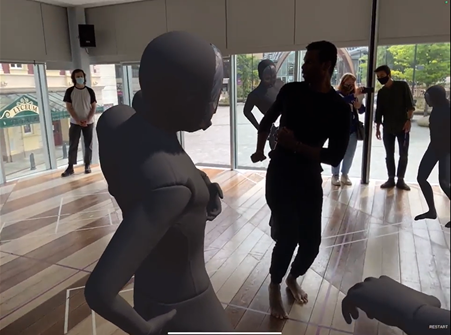This is the age of change for theatre, globally. The Covid-19 pandemic has led theatres to commission digital productions and encouraged audiences to embrace innovative ways of experiencing theatre, including projection, virtual reality, interactive media and live streaming on mobile apps. Yet it feels to me that theatre remains a fixed and unwieldy institution – one that needs a new direction if it is to open up.
Growing up in Nigeria in the 1970s, I was exposed to the travelling theatre performances of practitioners such as Hubert Ogunde, Lere Paimo, Duro Ladipo and ‘Baba Sala’. These ranged from stage plays to recorded plays on vinyl, and from performances on the television to photo plays. All this stimulated my interest in the versatility of the media of theatre production, and served as a precursor to my interest in digital tools to enhance, encode and preserve theatre performances, as well as to create access and keep artistic freedom at play.
I remember Ogunde’s troupe turning up at my boarding school in Nigeria in 1974, when I was 11. Our excitement in the quadrangle when it was announced during the morning assembly was palpable. We would be experiencing the work of the man known as the father of theatre in Nigeria! His lorry turned up after supper and we watched as the set was put together – as our ordinary-looking sports field was turned into a magical space. I remember how the line between us and the actors became blurred; audience members were joining in, as if we believed that what was happening before us was real. I was thinking about the story and the experience for months. Not in my wildest dreams could I have imagined the transformation that happened once the door of Hubert Ogunde’s lorry opened.
Practitioners such as Ogunde were part of Yoruba travelling theatre. A theatre troupe would arrive in a mini-bus and move round the town announcing the name of the show and the place where it would be taking place, and playing abstracts or audio-tape from previous productions. The megaphone commanded silence in all the nooks and crannies of the village whenever it boomed into the air. People would stop their discussions to listen to the announcer’s voice, and the songs that played, which were melodic and captivating. The practitioners showcased an array of theatre craft with a fusion of dialogue, song, chant, traditional folk tales, oral tradition and history, songs and audience participation. It was operatic, and sometimes labelled as such.
"…theatre remains a fixed and unwieldy institution – one that needs a new direction if it is to open up"
Professional practitioners, cast and crew travelled from one place to another, developing huge followings. They wrote stories that reflected the society in which they lived, be it social, religious, folkloric or political. Unfortunately most of these older-generation artists have died, with very little documentation of their work and craft, but there is so much to learn from them. Ogunde’s devising technique, for example, involved sketching out the basic situation and plot, and then writing down and rehearsing only the songs of his plays. It gave actors the freedom to adjust to the different audiences and environments they encountered.
Any experimental work that takes theatres out of traditional spaces interests me, including multidisciplinary work that responds to the site of performance, and work that interweaves live performance with film and installations. I want to find a way to interrogate the past and create extraordinary journeys that are visually layered and ambitious in scale. In my work, I have been exploring how video designs, virtual-reality masks for actors, mobile phone apps, gaming and computer animation can create a distinctively African theatre aesthetic, using technology to transcend the traditional location of theatre while retaining its ‘liveness’ and its human element.

My current project explores the use of technology and theatre spaces not commonly used in performance to tell the story of the life and tragic death of David Oluwale. He was a homeless British Nigerian who drowned in the River Aire in Leeds in 1969 after what has been described by the crime historian Kester Aspden as ‘brutal, systematic harassment … orchestrated by the Leeds city police force.’ His death resulted in the first successful prosecution of British police officers for involvement in the death of a Black person.
Our workshop of the story of David Oluwale experimented with representing an ethereal character by incorporating digital technologies. We engaged an augmented reality (AR) specialist to prototype and prove the concept of a small AR theatre experience – AR being an enhanced version of the real physical world that is achieved through the use of digital visual elements, sound or other sensory stimuli delivered via technology.
"By exploring what digital technology has to offer, I believe it is possible to add to the ‘liveness’ of a theatrical piece"
We plan to find ways for the artificially generated characters to respond to the actors’ movements and voices. By exploring what digital technology has to offer, I believe it is possible to add to the ‘liveness’ of a theatrical piece. In the next phase of our research we are going to explore adapting the play as a videogame, lifting scenes out of traditional theatrical architecture and opening up space for audience participation. We are asking ourselves a lot of questions. Can we make a video game as a complement to a live show? Is site-specific production a good way into gaming? Is it a question of setting short scenes of the play in different settings/unusual locations?
The spontaneous give and take between performers and spectators is central to the theatrical experience. Interactive technology and social media can contribute to this relationship and we discovered during our research that working in spaces outside of theatres and using virtual reality technology can create and enhance the relationships between performer, technology and audience. Mobile phones can also be used to produce audio-visual content, as well as to consume it, making it possible for alternative media productions to gain greater visibility. This, then, gives rise to a digital democracy of sorts, with not only creative implications but also clear sociopolitical significance. Digital technologies, in other words, can democratise the arts.
Avatars in space
The experience we offered played out as follows. A single live performer is in a space. The audience can view the performer through a smartphone, and see up to four avatars in space around them. The avatars – computer-generated images of David Oluwale’s ancestors – move with simple choreography, created by filming the performers and using their movements to animate the graphics. The audience can walk around the performer and experience a full 3D effect when viewing the performer and avatars through the device.
We also used AR to create a live performance. The effect was to project a live actor onto a mobile device, where they could be seen surrounded by avatars. These avatars, which represent David Oluwale’s ancestors, interact with the actor in the theatrical space. It’s a surreal experience that is difficult to explain.
It’s as if the actor is present with ghosts.

Mojisola Elufowoju is the CEO and Artistic Director of Utopia Theatre, a leading African theatre company resident at Sheffield’s Crucible Theatre. She was a recipient of the 2017 Opera Awards Foundation bursary and is a founding member of Mosaic Opera Collective.